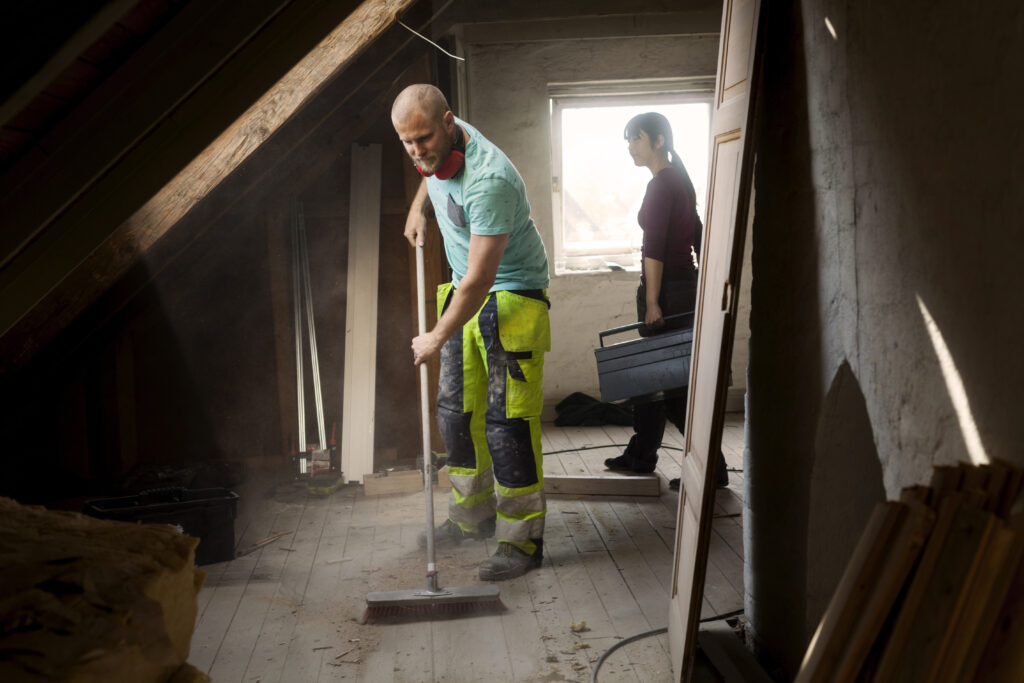Musty smell alert: If a trip into your loft or attic has greeted you with more “abandoned cellar” than “storage haven,” you’re not alone. Whether it’s a mild whiff of mildew or a full-blown stench, that telltale odour is your loft crying out for attention, and likely signalling hidden issues like damp, mould, poor insulation, or blocked ventilation.
Before you panic or bin your boxes of old Christmas decorations, take a breath. This guide will walk you through the process of diagnosing, fixing, and preventing that funky attic aroma.
Sniff Test: What Exactly Is a “Musty” Smell?
“Musty” isn’t just a word estate agents use when they’re trying to avoid saying “mouldy.” It’s a specific type of smell — earthy, stale, and damp, often associated with mildew, rot, or neglected areas where moisture and poor airflow meet.
In lofts and attics, this smell can be caused by:
- Moisture build-up from leaks or condensation
- Mould or mildew growth on insulation or timber
- Poor ventilation or blocked vents
- Infrequent access (lofts are often shut tight for months)
- Stored items like cardboard, clothes, or furniture absorb smells over time
So yes, your nose is trying to tell you something. And it might be serious, especially if damp is involved.
Common Causes of Musty Smells in UK Lofts and Attics
Let’s unbox the culprits behind the stench, one by one:
1. Damp and Condensation
Damp is public enemy number one when it comes to musty smells in lofts. Even if you don’t have visible leaks, condensation can build up over time, especially in the winter months when warm air rises from the house and hits the cold surfaces of your roof space.
Signs to look for:
- Water staining on beams or insulation
- Mould or mildew patches on timber or stored items
- Droplets of water on the underside of roofing felt or tiles
- A general cold, clammy feel
Fix it:
- Improve insulation and ventilation (more below)
- Check for leaks in the roof, especially around chimneys, vents, or tile joints
- Use a dehumidifier temporarily if necessary.
2. Inadequate or Blocked Loft Ventilation
Think of your loft like a tent: it needs airflow to stop condensation. If vents are blocked by insulation or debris, moisture becomes trapped, leading to dampness and unpleasant odours.
Older UK homes might lack dedicated loft vents altogether, while newer builds sometimes suffer from insulation being shoved over air bricks or soffit vents.
Fix it:
- Clear any blocked vents or air bricks
- Consider installing soffit, ridge, or gable vents
- Ensure insulation doesn’t block airflow pathways
3. Wet or Ineffective Insulation
Insulation is meant to keep your home warm — not soggy. If your loft insulation is holding moisture (from a leak or condensation), it becomes a breeding ground for bacteria and mould.
Check for:
- Sagging or damp fibreglass wool
- Compressed or discoloured patches
Fix it:
- Remove and replace wet insulation
- Upgrade to modern, breathable materials like sheep’s wool or PIR boards
- Always pair with improved ventilation
4. Mould and Mildew Growth
You can’t talk about musty smells without talking about mould. Mould spores thrive in dark, damp, still-air environments. So, lofts are prime real estate. It can affect wood, plasterboard, stored items, and even insulation.
Health-wise, mould is no joke: it can cause respiratory issues, allergies, and eye or skin irritation, especially for children or older adults.
Fix it:
- Use mould-resistant paint or sprays on affected areas
- If it’s widespread, consult a professional mould remediation service
- Always address the source of the damp first, don’t just mask the smell
5. Forgotten Storage Sins
Old books, damp cardboard boxes, suitcases of vintage clothes, your attic might be less of a storage solution and more of a sponge for smells. Once these items absorb moisture and dust, they begin to fester.
Fix it:
- Declutter ruthlessly
- Swap cardboard boxes for plastic storage containers with lids
- Store clothes in vacuum-sealed bags
- Add a few moisture-absorbing sachets or charcoal bags
How to Diagnose the Source: A Step-by-Step Loft Sniff Test
Not all smells are created equal, and finding the source is half the battle. Here’s your methodical approach to becoming a loft detective:
- Start with a visual scan: Any discolouration, obvious damp patches, or mould growth?
- Use your nose: Is the smell stronger near a particular corner or wall?
- Check insulation: Lift a patch to see if it’s damp underneath.
- Look at your roof: Any daylight peeking through where it shouldn’t be?
- Sniff stored items: If it smells like 1980s suitcases and forgotten duvets, you’ve got absorbing materials.
- Check vents: Are they blocked or dirty?
Log your findings, and take pictures if you plan to get a second opinion.
The Fix-It List: How to Get Rid of That Musty Smell
Once you’ve identified the cause, it’s time to take action. Here’s a full checklist of remedies:
1. Clean
- Remove mould with appropriate sprays or a vinegar solution
- Hoover or sweep out dust and cobwebs
- Disinfect wooden beams or walls where needed
2. Ventilate
- Install or unblock vents
- Consider adding a solar-powered roof fan
- Leave the loft hatch open on dry days to promote air flow
3. Declutter and Deodorise
- Use silica gel packets or baking soda trays to absorb lingering moisture
- Try activated charcoal bags (widely available online)
- Scented sachets can help, but only after cleaning
4. Repair
- Patch roof leaks
- Replace damp insulation
- Redirect bathroom or kitchen extractor fans that vent into the loft (they shouldn’t)
When to Call in the Professionals
While many issues can be sorted with a bit of elbow grease and persistence, some situations call for a specialist:
- Widespread black mould on timber or rafters
- Structural damage from rot or long-term damp
- Leaks you can’t trace
- Asbestos concerns in older insulation
Loft companies, damp specialists, and mould remediation services are your best bet. Get at least two quotes, and always ask about guarantees and certifications.

Prevention: How to Keep Musty Smells Away for Good
Like most household issues, prevention is cheaper and easier than a cure. Here’s how to keep your loft sweet-smelling and structurally sound:
1. Annual Loft MOT
Set a reminder to inspect your loft at least once a year, ideally after winter.
2. Upgrade Insulation the Right Way
Modern insulation materials resist moisture better. If you’re doing a loft conversion or energy upgrade, insist on breathable, natural materials.
3. Maintain Ventilation
Even in summer, poor airflow leads to stale air. Keep vents clear and consider passive ventilation upgrades if your home is older.
4. Smart Storage
Ditch cardboard boxes. Use plastic tubs with tight lids and don’t overfill. Rotate stored clothes and soft goods annually.
5. Monitor Moisture
Invest in a digital hygrometer to keep tabs on humidity levels. Anything consistently above 60% could be a red flag.
Eco-Friendly and Natural Deodorisers
If you’ve cleaned and fixed everything but still have a faint musty pong, try these eco-friendly fixes:
- A bowl of white vinegar left in the loft for 24–48 hours
- Baking soda in open containers near affected areas
- Essential oils on cotton balls — eucalyptus, tea tree, or lavender work well
- Bamboo charcoal bags (natural and reusable)
Avoid strong chemical air fresheners — they’ll just mask the problem and could make ventilation worse.
Bonus: Could It Be Rodents?
If the smell has an ammonia edge, or you’ve heard the pitter-patter of uninvited feet overhead, you might have mice or rats. They can bring their brand of unpleasant odour, especially if nesting in insulation.
Look for:
- Droppings
- Chewed boxes or wires
- Nests made of shredded materials
Call pest control if unsure, and block entry points via eaves or loose tiles.
Final Word: Don’t Ignore That Musty Smell!
A musty loft is more than a nuisance; it can be a warning sign of bigger problems like roof leaks, poor insulation, or hidden damp. But the good news? Most issues are fixable with a bit of investigation and TLC.
Start with your nose, follow it with some common sense (and maybe a dehumidifier), and don’t hesitate to call in help if needed. Your loft doesn’t have to smell like a haunted cottage; it can be a dry, fresh, and functional space with just a little effort.
Have your hacks for banishing loft smells? Share them in the comments, and check back for more home care tips at thehouseholddaily.


















